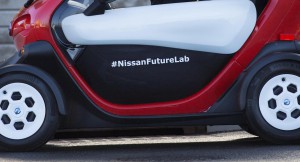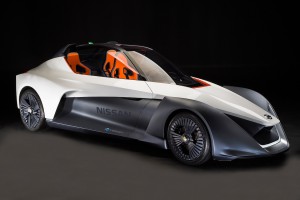
Nissan is in the midst of several experimental scenarios about the future of mobility at the Nissan Future Lab.
Automakers around the world are scrambling to make sure they have their fingers in the next great transportation shift. Electric vehicles, fuel cells, ride-sharing, autonomous cars … most makers are invested in some way.
Nissan is no different than the rest; however, its approach to finding – and capitalizing on – the next great thing is a little different. The Japanese maker is using a two-pronged approach.
First, the company is developing three “mobility” scenarios to see if the promise can meet the reality. Second, Nissan is using a more traditional method of employing cutting edge technologies in prototypes placed in real-world environments.
As part of the first “prong,” the company is in the midst of a series of experiments to bring those concepts to life through “living labs” at Nissan Future Lab. Currently, Nissan is playing out ventures in vehicle ownership structures, changes in technology and new uses for electric vehicles.
Nissan Future Lab is an extension of Nissan’s global advanced planning group and looks decades ahead to identify potential issues and opportunities for the business today and into the future.
Established in 2014, it looks beyond products and examines the future of mobility in a wider sense.

BladeGlider is Nissan's vision for an agile, efficient electric vehicle that would provide new dimensions of driving fun and excitement.
“Working within the living lab framework allows Nissan to experiment out in the marketplace,” said Rachel Nguyen, executive director, Nissan Future Lab. “By combining our hardware with outside software, services and systems into collaborative beta tests, Nissan has the opportunity to develop new products and service offerings that fit in the new mobility economy.”
The emergence of a the “sharing” economy has Nissan examining the best way to participate in car-sharing ventures. Last October, Nissan launched its first “Living Lab” with Scoot Networks to bring 10 Nissan New Mobility Concept Vehicles (NNMC) to Scoot’s fleet in San Francisco.
The electric-powered “micromobility” vehicles are bigger than small motorcycle but smaller than a full-size vehicle. Ideally, they would be used for personal transport in urban areas for short trips.
Nissan’s made them available for rental using the Scoot app sharing platform. Through the pilot, Nissan is gathering data on city dwellers mobility choices for short distance trips, and the role electric vehicles play as shared transportation options.
(Nissan enjoys strong quarterly earnings. To get the details, Click Here.)
The concept of a sharing economy also presents makers with new ways to leverage vehicle technology. While car sharing sounds great on the surface, digging a little deeper reveals a few problems, not the least of which is redistributing shared vehicles to their points of origin.
The Scoot “Living Lab” is also providing data on vehicle distribution to help Nissan better understand the distance traveled from the origin, popular origin points and other user behaviors.
Nissan is also actively studying the expanded use of electric vehicles including vehicle-to-grid (V2G) technology. Since 2014, Nissan has participated in a large V2G pilot program with the U.S. Air Force.
A fleet of modified Nissan Leaf electric vehicles discharge power back into the gird through a series of bi-directional charging stations. The exchange is used to balance the overall load by absorbing excess power, then putting it back into the grid during times of high demand.
“The Future Lab team is exploring ‘Living Lab’ projects designed to help us better understand the real-world benefits of V2G technology for individual electric vehicle consumers and how it fits into their mobility lifestyle in the future,” added Nguyen.
(Click Here to see more about the mid-engined Corvette moving from rumor to reality.)
The second “prong” places a new vehicle in full view of the public, in this case in Rio de Janeiro, Brazil. As thousands of Olympic athletes are looking to score gold, Nissan is also looking to score … with potential consumers with its BladeGlider prototype.
Two years in the making, the BladeGlider prototype is part of Nissan’s on-going commitment to the development of zero-emission vehicles and new automotive technologies including autonomous drive systems and connectivity.
With the Nissan BladeGlider, Nissan’s vision was for an agile, efficient EV that would provide new dimensions of driving fun and excitement – a car that would “glide,” thanks to the near-silent performance of its electric powertrain and aerodynamic shape.
The prototype sports an advanced chassis configuration with a narrow front track and wider rear track for optimum aerodynamic efficiency and handling stability. High-waisted, rear-hinged dihedral doors provide a dramatic entry and exit to the cabin.
The open roof is reinforced with an integrated roll-over protection structure, providing the exhilaration of an open-topped race car with the safety of a coupe.
Wheel-mounted controls for Nissan BladeGlider’s systems feed into an advanced display showing speed, state of battery charge, regeneration mode and torque map. Flanking the central display are two screens, with the images of rear-view cameras mounted just behind the front wheels.
An alternative to door-mounted mirrors, this dual screen design improves the aerodynamic efficiency of Nissan BladeGlider. The driver sits in arrowhead formation slightly in front of two passengers, who enjoy extended legroom. The view for all occupants is panoramic thanks to the seamless cockpit windscreen.
Power is 100% electric, Nissan officials note, with a maximum speed of the demonstration models is in excess of 115 mph with an expected zero-to-60 mph of less than five seconds. The rear wheels’ drive is provided by two 130kW electric motors – one for each wheel.
(High-tech safety features “APEAL” to consumers, says J.D. Power study. For more, Click Here.)
“These prototypes epitomize Nissan’s drive to expand its Intelligent Mobility strategy, where driving pleasure combines with environmental responsibility,” said Carlos Ghosn, president and chief executive officer, Nissan Motor Co., Ltd. “Nissan believes that enthusiasts should look forward to a zero emission future and Nissan BladeGlider is a perfect demonstration of that. It’s the electric vehicle for car lovers.”
